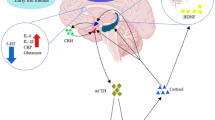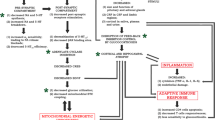Abstract
The vascular depression hypothesis suggests that there is an association between cerebrovascular pathophysiology and depression in the elderly. We investigated depressive-like behaviors and perturbations in the hypothalamus-pituitary-adrenal (HPA) axis in a rat model of chronic cerebral hypoperfusion. We modeled chronic cerebral hypoperfusion by permanent occlusion of the bilateral common carotid arteries (BCCAo) in Wistar rats. Sucrose preference, forced swim, and social interaction tests were performed to measure depressive-like behaviors. The plasma levels of adrenocorticotropic hormone and corticosterone, and the hippocampal expression of the glucocorticoid receptor (GR) were assessed. Sucrose preference (P = 0.045) and social withdrawal (P = 0.038) were significantly enhanced in BCCAo rats. Increased plasma levels of corticosterone (P = 0.034) and impaired cytosolic-to-nuclear translocation of the GR protein were observed in the hippocampus (P = 0.038) of BCCAo rats. Our experimental results support the clinical hypothesis that vascular depression can be induced by chronic cerebral hypoperfusion. Increased HPA axis activity and perturbation of the GR signaling pathway in the hippocampus may be associated with depressive-like behaviors in rats with chronic cerebral hypoperfusion.




Similar content being viewed by others
References
Beekman AT, Copeland JR, Prince MJ. Review of community prevalence of depression in later life. Br J Psychiatry. 1999;174:307–11.
Steffens DC, Krishnan KR, Crump C, Burke GL. Cerebrovascular disease and evolution of depressive symptoms in the cardiovascular health study. Stroke. 2002;33(6):1636–44.
Alexopoulos GS. Depression in the elderly. Lancet. 2005;365(9475):1961–70.
Tiemeier H, van Dijck W, Hofman A, Witteman JC, Stijnen T, Breteler MM. Relationship between atherosclerosis and late-life depression: the Rotterdam Study. Arch Gen Psychiatry. 2004;61(4):369–76. doi:10.1001/archpsyc.61.4.369.
Camus V, Kraehenbuhl H, Preisig M, Bula CJ, Waeber G. Geriatric depression and vascular diseases: what are the links? J Affect Disord. 2004;81(1):1–16. doi:10.1016/j.jad.2003.08.003.
Alexopoulos GS. The vascular depression hypothesis: 10 years later. Biol Psychiatry. 2006;60(12):1304–5.
Alexopoulos GS, Kiosses DN, Klimstra S, Kalayam B, Bruce ML. Clinical presentation of the “depression-executive dysfunction syndrome” of late life. Am J Geriatr Psychiatry. 2002;10(1):98–106.
Roh JH, Lee JH. Recent updates on subcortical ischemic vascular dementia. J Stroke. 2014;16(1):18–26. doi:10.5853/jos.2014.16.1.18.
Neigh GN, Kofler J, Meyers JL, Bergdall V, La Perle KM, Traystman RJ, et al. Cardiac arrest/cardiopulmonary resuscitation increases anxiety-like behavior and decreases social interaction. J Cereb Blood Flow Metab. 2004;24(4):372–82.
Wang SH, Zhang ZJ, Guo YJ, Teng GJ, Chen BA. Hippocampal neurogenesis and behavioural studies on adult ischemic rat response to chronic mild stress. Behav Brain Res. 2008;189(1):9–16. doi:10.1016/j.bbr.2007.11.028.
Nemeth CL, Shurte MS, McTigue DM, Nemeroff CB, Neigh GN. Microembolism infarcts lead to delayed changes in affective-like behaviors followed by spatial memory impairment. Behav Brain Res. 2012;234(2):259–66. doi:10.1016/j.bbr.2012.06.014.
Choi BR, Lee SR, Han JS, Woo SK, Kim KM, Choi DH, et al. Synergistic memory impairment through the interaction of chronic cerebral hypoperfusion and amlyloid toxicity in a rat model. Stroke. 2011;42(9):2595–604.
Choi BR, Kwon KJ, Park SH, Jeon WK, Han SH, Kim HY, et al. Alternations of septal-hippocampal system in the adult Wistar rat with spatial memory impairments induced by chronic cerebral hypoperfusion. Exp Neurobiol. 2011;20(2):92–9. doi:10.5607/en.2011.20.2.92.
Jiwa NS, Garrard P, Hainsworth AH. Experimental models of vascular dementia and vascular cognitive impairment: a systematic review. J Neurochem. 2010;115(4):814–28. doi:10.1111/j.1471-4159.2010.06958.x.
Farkas E, Luiten PG, Bari F. Permanent, bilateral common carotid artery occlusion in the rat: a model for chronic cerebral hypoperfusion-related neurodegenerative diseases. Brain Res Rev. 2007;54(1):162–80. doi:10.1016/j.brainresrev.2007.01.003.
de Kloet ER, Joels M, Holsboer F. Stress and the brain: from adaptation to disease. Nat Rev Neurosci. 2005;6(6):463–75.
Gomez F, Lahmame A, de Kloet ER, Armario A. Hypothalamic-pituitary-adrenal response to chronic stress in five inbred rat strains: differential responses are mainly located at the adrenocortical level. Neuroendocrinology. 1996;63(4):327–37.
Mizoguchi K, Ishige A, Aburada M, Tabira T. Chronic stress attenuates glucocorticoid negative feedback: involvement of the prefrontal cortex and hippocampus. Neuroscience. 2003;119(3):887–97.
Raone A, Cassanelli A, Scheggi S, Rauggi R, Danielli B, De Montis MG. Hypothalamus-pituitary-adrenal modifications consequent to chronic stress exposure in an experimental model of depression in rats. Neuroscience. 2007;146(4):1734–42.
Guidotti G, Calabrese F, Anacker C, Racagni G, Pariante CM, Riva MA. Glucocorticoid receptor and FKBP5 expression is altered following exposure to chronic stress: modulation by antidepressant treatment. Neuropsychopharmacology. 2013;38(4):616–27. doi:10.1038/npp.2012.225.
Moretti R, Torre P, Antonello RM, Cazzato G. Behavioral alterations and vascular dementia. Neurologist. 2006;12(1):43–7. doi:10.1097/01.nrl.0000186806.54314.e8.
Morales-Medina JC, Dumont Y, Benoit CE, Bastianetto S, Flores G, Fournier A, et al. Role of neuropeptide Y Y(1) and Y(2) receptors on behavioral despair in a rat model of depression with co-morbid anxiety. Neuropharmacology. 2012;62(1):200–8. doi:10.1016/j.neuropharm.2011.06.030.
File SE, Seth P. A review of 25 years of the social interaction test. Eur J Pharmacol. 2003;463(1–3):35–53.
Stack A, Carrier N, Dietz D, Hollis F, Sorenson J, Kabbaj M. Sex differences in social interaction in rats: role of the immediate-early gene zif268. Neuropsychopharmacology. 2010;35(2):570–80. doi:10.1038/npp.2009.163.
Anisman H, Matheson K. Stress, depression, and anhedonia: caveats concerning animal models. Neurosci Biobehav Rev. 2005;29(4–5):525–46. doi:10.1016/j.neubiorev.2005.03.007.
Christensen L, Pettijohn L. Mood and carbohydrate cravings. Appetite. 2001;36(2):137–45. doi:10.1006/appe.2001.0390.
Jeffery RW, Linde JA, Simon GE, Ludman EJ, Rohde P, Ichikawa LE, et al. Reported food choices in older women in relation to body mass index and depressive symptoms. Appetite. 2009;52(1):238–40. doi:10.1016/j.appet.2008.08.008.
Bathgate D, Snowden JS, Varma A, Blackshaw A, Neary D. Behaviour in frontotemporal dementia, Alzheimer’s disease and vascular dementia. Acta Neurol Scand. 2001;103(6):367–78.
Cullen P, Abid F, Patel A, Coope B, Ballard CG. Eating disorders in dementia. Int J Geriatr Psychiatry. 1997;12(5):559–62. doi:10.1002/(SICI)1099-1166(199705)12:5<559::AID-GPS550>3.0.CO;2-W.
Ikeda M, Brown J, Holland AJ, Fukuhara R, Hodges JR. Changes in appetite, food preference, and eating habits in frontotemporal dementia and Alzheimer’s disease. J Neurol Neurosurg Psychiatry. 2002;73(4):371–6.
Piguet O, Petersen A, Yin Ka Lam B, Gabery S, Murphy K, Hodges JR, et al. Eating and hypothalamus changes in behavioral-variant frontotemporal dementia. Ann Neurol. 2011;69(2):312–9. doi:10.1002/ana.22244.
Willner P, Benton D, Brown E, Cheeta S, Davies G, Morgan J, et al. “Depression” increases “craving” for sweet rewards in animal and human models of depression and craving. Psychopharmacology (Berl). 1998;136(3):272–83.
Sinitskaya N, Schuster-Klein C, Guardiola-Lemaitre B, Gourmelen S, Pevet P, Challet E. Short day-length increases sucrose consumption and adiposity in rats fed a high-fat diet. Psychoneuroendocrinology. 2008;33(9):1269–78.
Morton GJ, Cummings DE, Baskin DG, Barsh GS, Schwartz MW. Central nervous system control of food intake and body weight. Nature. 2006;443(7109):289–95.
Petit-Demouliere B, Chenu F, Bourin M. Forced swimming test in mice: a review of antidepressant activity. Psychopharmacology (Berl). 2005;177(3):245–55. doi:10.1007/s00213-004-2048-7.
West AP. Neurobehavioral studies of forced swimming: the role of learning and memory in the forced swim test. Prog Neuropsychopharmacol Biol Psychiatry. 1990;14(6):863–77.
Nam H, Clinton SM, Jackson NL, Kerman IA. Learned helplessness and social avoidance in the Wistar-Kyoto rat. Front Behav Neurosci. 2014;8:109. doi:10.3389/fnbeh.2014.00109.
Starkstein SE, Mizrahi R, Garau L. Specificity of symptoms of depression in Alzheimer disease: a longitudinal analysis. Am J Geriatr Psychiatry. 2005;13(9):802–7. doi:10.1176/appi.ajgp.13.9.802.
Chollet F, Tardy J, Albucher JF, Thalamas C, Berard E, Lamy C, et al. Fluoxetine for motor recovery after acute ischaemic stroke (FLAME): a randomised placebo-controlled trial. Lancet Neurol. 2011;10(2):123–30.
Young-Xu Y, Chan KA, Liao JK, Ravid S, Blatt CM. Long-term statin use and psychological well-being. J Am Coll Cardiol. 2003;42(4):690–7.
Renshaw PF, Parsegian A, Yang CK, Novero A, Yoon SJ, Lyoo IK, et al. Lovastatin potentiates the antidepressant efficacy of fluoxetine in rats. Pharmacol Biochem Behav. 2009;92(1):88–92. doi:10.1016/j.pbb.2008.10.017.
Compliance with Ethics Requirements
Conflict of Interest
Sang Rim Lee, Bo-Ryoung Choi, Saswati Paul, Ju-Ha Seo, Dong Bin Back, Jung-Soo Han, Dong-Hee Choi, Kyoung Ja Kwon, Chan Young Shin, Jongmin Lee, Seol-Heui Han, and Hahn Young Kim declare that they have no conflict of interest. All institutional and national guidelines for the care and use of laboratory animals were followed.
Funding
This research was supported by the Basic Science Research Program through the National Research Foundation of Korea (NRF) funded by the Ministry of Education, Science and Technology (2010–0008867).
Author information
Authors and Affiliations
Corresponding author
Rights and permissions
About this article
Cite this article
Lee, S.R., Choi, B., Paul, S. et al. Depressive-Like Behaviors in a Rat Model of Chronic Cerebral Hypoperfusion. Transl. Stroke Res. 6, 207–214 (2015). https://doi.org/10.1007/s12975-014-0385-3
Received:
Revised:
Accepted:
Published:
Issue Date:
DOI: https://doi.org/10.1007/s12975-014-0385-3




